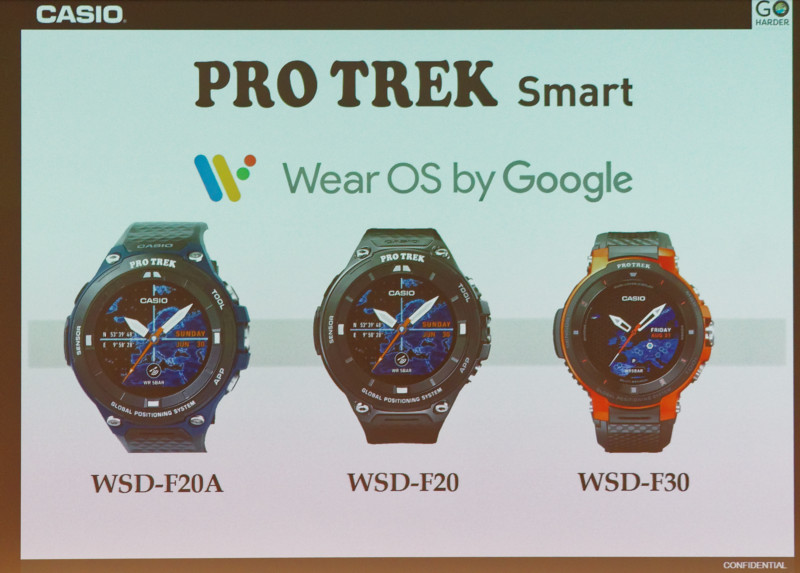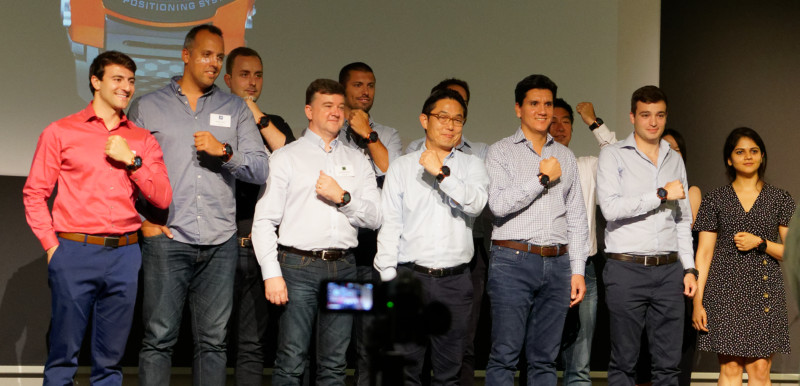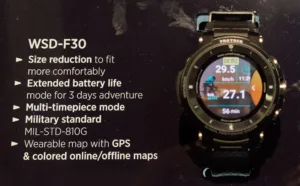Casio has been developing its Pro Trek brand for outdoor watches and more recently the company has been developing smart products. Kazuyuki Yamashita is a senior executive from Casio Japan and he explained the developments.

WSD F10 was the first smart watch from Casio and was intended for outdoor users. Location data and maps were supplied for outdoor users. It was launched in 2016 (Casio’s Smartwatch Can Take a Beating) and had a dual layer display and was the first to meet Mil-spec and in 2017, the Pro-Trek WSD-F20 was introduced and added offline map storage. (This reporter noted the dual layer display when we spotted it at CES in 2017 – the rear display is a full colour emissive display, while the front display is a transparent reflective LCD that can show the time and less detailed information, but consumes very little power.)
Now the WSD-F30 is the new model with a revised industrial design and new features. The F30 is based on the latest WearOS from Google and will be sold alongside the WSD-F20 and WSD-F20A, which continue.
 The WSD-F30 will sell alongside the current products. Image:Meko
The WSD-F30 will sell alongside the current products. Image:Meko
Casio builds its Pro Trek watches to meet Mil-std-810G for shock and the company first developed this technology for its G-Shock watches. The watch is resistent to damage from dropping/ vibration, humidity, extremes of temperature, pressure change, freezing and thermal shock. The Pro Trek watch is used by a police region in Japan and although they were lost after bad sediment coverage after an earthquake, but even in these extreme conditions, they survived OK.
The system can use maps other than Google so that GPS and navigation can be supported in areas that do not have cellular coverage. Applications on the WSD-F20 include apps from nine companies with global reach. These are for trekking, fishing, surfing, skiing, golf and swimming.
The F30 shows data on the white LCD and coloured OLED. Image:Meko
The F30 is 3.9mm narrower and 0.4mm slimmer than the previous F20 and has better power management which means longer display and the top layer can now show sensor data, but in many ways has the same base spec as previous models.
Dual display can show compass headings, readings from the altimeter or air pressure, which is good for understanding weather trends.
The battery life is 1.5 days in ‘normal’ use. There is a three day extended mode that can support the sensors and a colour map and the F30 can run for up to one month if it is just used for time and sensors using the LCD top display. The main display is a new OLED rather than the previous LCD and is 1.2″ round with 390 x 390 resolution.
Casio then brought on its software partners to briefly introduce their apps.
 Casio’s partners showed off their watches! Image:Meko
Casio’s partners showed off their watches! Image:Meko
Viewranger is for outdoor use and is used by over 400 search and emergency organisations. Trail guides can be automatically downloaded.
Hole19 is a golf app that helps golfers and acts as a social network for golfers. It also collects data on strokes and accuracy as well as showing maps of courses.
Glassy is for water sports and for surfing. It has a large database of surfing locations and has forecasts for surfing conditions.
Fishbrain is said to be the #1 fishing app and provides forecasts and tracks catches. Coming soon is voice activation and operation.
MySwim Pro is for swimming and provides workouts and plans as well as developing analytics based on data collected by the watch.
Equilab is an equestrian programme and helps riders keep better track of horse activity. The movement of the horse can improve the development of exercise for the horse.
Excercise Timer allows the analysis of planning of workouts.
Zombies, Run! is a smartphone running game where you have a story to make running more interesting (escape the Zombies!) and now supports the watch.
Ski Tracks has information or resorts and lifts as well as local weather and measurement data without the need for a smartphone.
Miles Barr is from Google and looks after Wear OS. He said that it has a new version with new ‘glanceable interactions’ for the wrist. Most interactions with watches are just five secs or less so Wear OS has added new features for swiping to get simple notifications. There is a new Google Fit app that adds new activity goals and was developed with a number of very respectable-sounding health authorities.
Google Assistant has been improved to account in its responses for the time of day and for typical activities and locations. Improvements will roll out over the next month.

